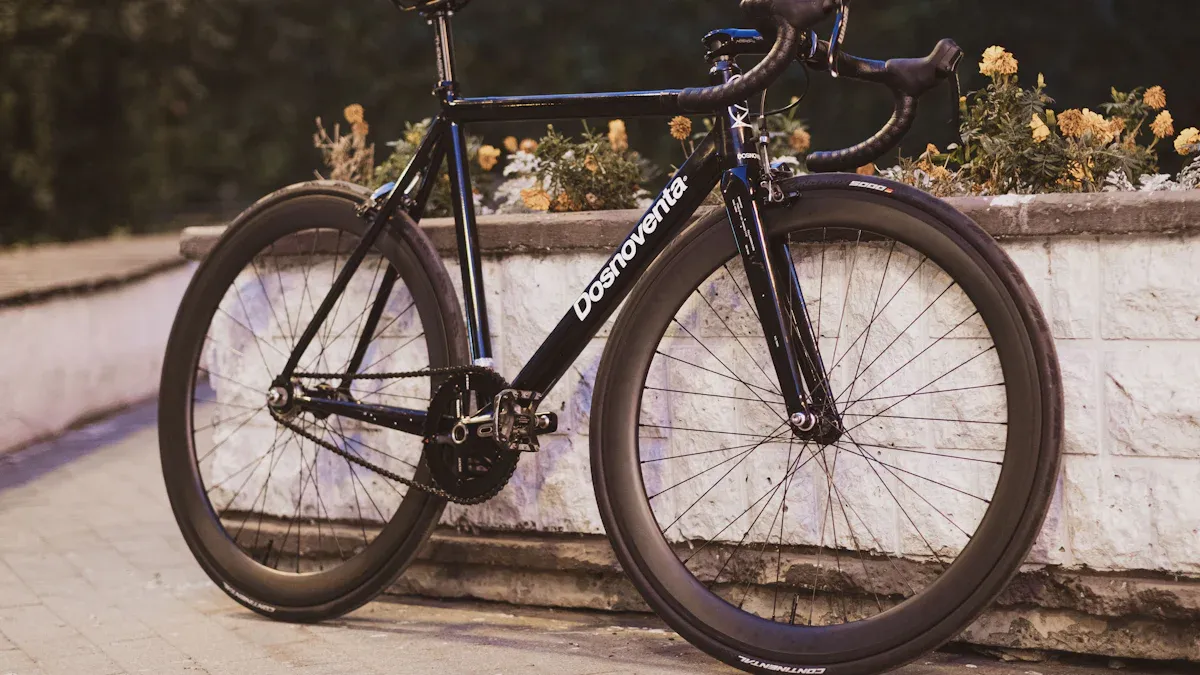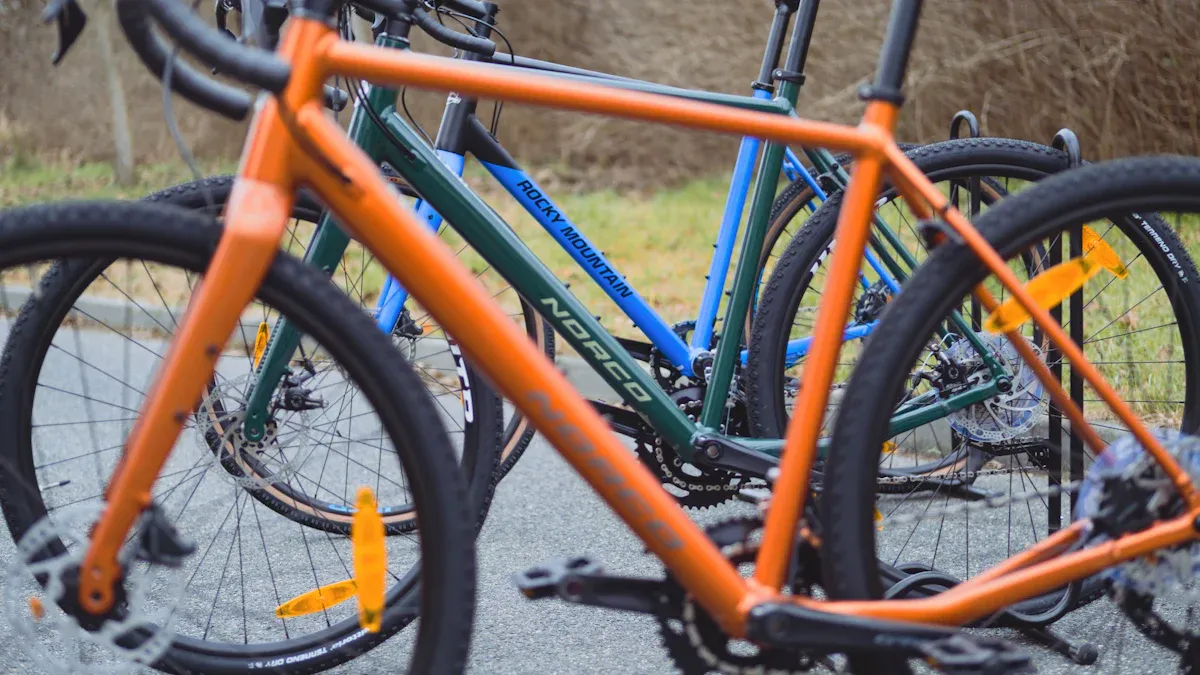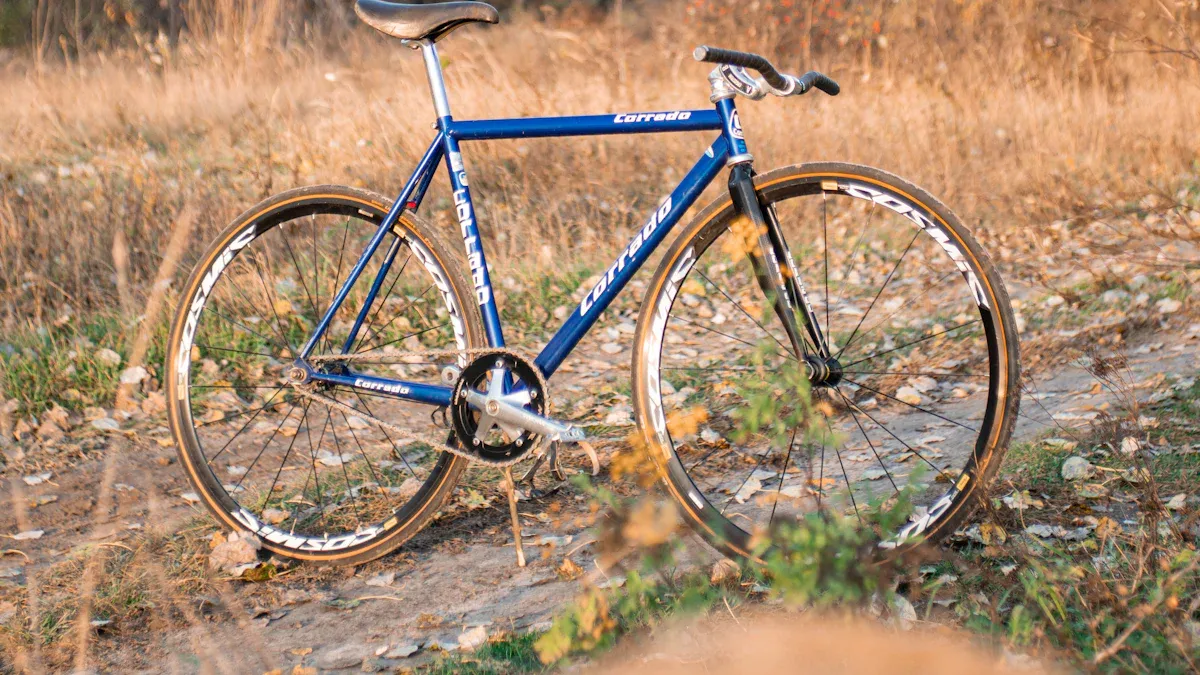
Understanding bike geometry, particularly road bike frame geometry, is important for your comfort and control on the road. How a bike is built affects how you feel when riding. For example, experts say that the stiffness of the axle affects how well you can turn. Also, the rider’s position can change how the bike handles. A bike that fits you well can help reduce pain and tiredness, especially for new riders. By learning the basics of road bike frame geometry, you can make smart choices that improve your ride. In this blog, we will look at different frame shapes, like endurance, race, aero, and cyclocross. This will help you find the best fit for your style.
Key Takeaways
Knowing bike geometry is important for comfort and control when riding. A bike that fits well helps reduce pain and tiredness, especially for new riders.
Important measurements like stack and reach affect your riding position. A higher stack gives comfort, while a longer reach helps with a racing position.
Different bike shapes have different uses. Endurance bikes focus on comfort, while race and aero bikes aim for speed and performance.
Always make sure your bike fits well to avoid injuries. A good fit can stop common problems like knee pain and back strain.
Talking to experts and trying out different bikes can help you find the best fit for your riding style and goals.
Key Terms in Bike Geometry
Knowing key terms in bike geometry helps you choose a bike wisely. Here are some important measurements:
Frame Size and Fit
Frame size and fit are very important for comfort and performance. A bike that fits you well can lower the chance of injury and improve your ride. Research shows that a good bike fit can greatly reduce pain and injury risk, especially in the knee and pelvis areas. You should always focus on finding the right size for your body.
Stack and Reach
Stack and reach are two key measurements that affect your riding position.
Stack: This is the vertical distance from the bottom bracket to the top of the head tube. A higher stack lets you sit more upright, which is often more comfortable for long rides.
Reach: This is the horizontal distance from the bottom bracket to the top of the head tube. A longer reach can create a more aggressive riding position, which is good for racing.
These measurements help make bike geometry similar across different brands, making it easier for you to compare sizes.
Head Tube Angle
The head tube angle affects how your bike handles.
A steeper head tube angle makes steering quicker, improving agility but may cause twitchiness at high speeds.
A shallower angle gives more stability, making your ride smoother but can lead to understeering.
This angle sets how responsive and stable your bike feels.
Seat Tube Angle
The seat tube angle affects how efficiently you pedal.
A steeper angle boosts cycling efficiency and lowers cardio-respiratory costs.
A change of just 3 degrees can greatly impact muscle use and performance.
Choosing the right seat tube angle can improve your power output and overall comfort.
Wheelbase
Wheelbase is the distance between the front and rear axles.
Stability at High Speeds | Maneuverability in Tight Turns | |
|---|---|---|
Longer Wheelbase | Increased stability | Decreased agility |
Shorter Wheelbase | Decreased stability | Increased agility |
A longer wheelbase gives stability at high speeds, while a shorter wheelbase allows for better maneuverability in tight turns.
Understanding these key terms in bike geometry will help you pick a bike that matches your riding style and improves your overall experience.
Types of Road Bike Frame Geometry

Knowing the different types of road bike frame geometry helps you pick the right bike for your riding style. Each type has a special purpose and meets different needs.
Endurance Geometry
Endurance geometry is all about comfort and stability. It is great for long rides. This type of bike geometry has:
A more relaxed and upright riding position than racing bikes.
A longer head tube and wheelbase for better stability.
A shorter frame reach and taller frame stack for a comfy posture on long rides.
Wider tires (usually 28mm to 32mm) for better grip and stability on different surfaces.
These features help you stay comfortable for a long time, which reduces tiredness.
Feature | Description |
|---|---|
Upright Geometry | Longer head tubes give a more upright position, making long rides more comfy. |
A longer wheelbase adds stability, leading to smoother steering. | |
Chainstay Length | The chainstay length affects how well you balance speed and comfort. |
Race Geometry
Race geometry focuses on speed and aerodynamics. It is perfect for competitive cyclists. Key features include:
A longer top tube and shorter head tube for a more aggressive riding position.
A longer reach and shorter stack for a lower, aerodynamic stance.
A shorter wheelbase for better maneuverability, but it may lose some stability.
These features help you go faster and perform better in races. Aerodynamic drag uses up 85% of your power on flat ground, so it is important to optimize your position and bike design.
Feature | Race Geometry | Endurance Geometry |
|---|---|---|
Top Tube Length | Long | Short |
Head Tube Length | Short | Long |
Reach | Long Reach | Short Reach |
Stack | Short Stack | Long Stack |
Wheelbase | Short Wheelbase (usually < 1m) | Long Wheelbase (usually > 1m) |
Riding Position | Lower, aerodynamic | More upright, comfortable |
Seat Tube Inclination | Steeper for efficiency | Less steep for comfort |
Aero Geometry
Aero geometry is made for maximum speed, especially in time trials. This geometry has:
A more aggressive, lower, and forward riding position.
A lower stack height and longer reach for better aerodynamics.
Frame designs that reduce wind resistance, like Kamm tail shapes and built-in cockpits.
These changes help you cut through the wind better, allowing for faster rides. Wind tunnel tests show that improving rider position can greatly lower drag, which is key for going faster.
Feature | Aero Road Bikes | Endurance Road Bikes |
|---|---|---|
Riding Position | More aggressive, lower and forward | More relaxed, upright |
Stack Height | Lower stack height | |
Reach | Longer reach for aerodynamics | Shorter reach for comfort |
Purpose | Speed-focused, ideal for time trials | Comfort-focused, ideal for long rides |
Cyclocross Geometry
Cyclocross geometry mixes features from road and off-road bikes. This makes it good for different terrains. Key points include:
Frame shapes that are similar to road bikes for better handling on various surfaces.
Tire space for 33mm tires, which is important for off-road riding.
A steeper head tube angle for quick handling, allowing for fast turns.
These features help you move through tough courses while staying stable. Cyclocross bikes are not made for very technical off-road areas, as racers often get off and carry their bikes in those situations.
Feature | Cyclocross Bikes | All-Road Bikes |
|---|---|---|
Bottom Bracket Height | Higher for ground clearance | Lower for better balance |
Head Tube Angle | Steeper for quick handling | Slacker for more stability |
Chainstay Length | Shorter for fast acceleration | Longer for comfort on longer rides |
By knowing these geometries, you can make smart choices that improve your riding experience. Each bike geometry type has special benefits for different riding styles, helping you find the best fit for your needs.
Comparing Road Bike Geometries
Comfort vs. Performance
When picking a bike, comfort and performance often compete. Different geometries meet these needs in special ways. For example, endurance bikes focus on comfort. They have a taller stack height and a shorter reach. This helps you stay relaxed during long rides. On the other hand, race and aero geometries aim for performance. They have a lower stack height and longer reach. This can create a more aggressive riding position.
Here’s a quick comparison of key measurements across different bike types:
Bike Type | Stack Height (mm) | Reach (mm) | Chainstay (mm) | Wheelbase (mm) |
|---|---|---|---|---|
Endurance | 590 | 378 | 415 | 993 |
Race | 560 | 393 | 410 | 988 |
Aero | 560 | 393 | 410 | 988 |
This table shows that endurance bikes give more comfort. Race and aero bikes boost performance. Endurance bikes have a higher stack height. This helps you sit upright and eases strain on your back and neck. In contrast, race and aero bikes have lower stack heights. This can improve aerodynamics but may cause discomfort on long rides.
Handling Characteristics
Handling characteristics also change a lot among bike geometries. A bike’s geometry affects how it reacts to your movements, especially when turning or going downhill.
Endurance bikes offer stability, making them easier to control on long rides. Their longer wheelbase helps keep balance, especially on bumpy surfaces.
Race bikes provide quick handling, letting you turn sharply with ease. However, this speed can reduce stability at high speeds.
Aero bikes are made for speed, but their aggressive geometry can feel twitchy, especially for new riders.
Knowing these differences can help you find a bike that fits your riding style. If you like long, easy rides, an endurance bike is a good choice. If you enjoy racing or fast group rides, a race bike might be better.
Real-World Examples
To show these geometries, look at these popular bikes:
Description | Good For | Not Good For | |
|---|---|---|---|
Aero Road Bikes | Made for speed with aerodynamic features, like TT bikes. | Fast riding / racing | Slower, relaxed rides |
Commuter Bikes | Built for comfort and durability, with an upright position. | Daily reliability | Thrilling bike handling |
Touring Bikes | Designed for long distances with heavy loads, offering comfort. | Touring, commuting | Racing, speed work |
Time Trial Bikes | Focused on speed with aerodynamic design, great for racing. | Racing Time Trials or Triathlons | Quick trips, touring |
These examples show how different bike geometries fit specific needs. If you want to race, an aero road bike or time trial bike will help you succeed. If you prefer comfort for daily rides or touring, a commuter or touring bike will work better for you.
Common Mistakes in Bike Geometry Selection
Choosing the right bike geometry can be hard. Many riders make mistakes that hurt their comfort and performance. Here are some things to avoid:
Overlooking Fit
One big mistake is not paying attention to fit. A bike that fits you well is very important. It helps reduce discomfort and stops injuries. If you ignore bike fit, you might have problems with alignment. This can cause strain on your body, leading to pain and injuries. Common issues include:
Knee pain from the saddle being too high or low.
Low back pain from a position that is too aggressive.
Neck and shoulder issues from reaching too far for the handlebars.
Hand and wrist numbness from bad bike setup.
To avoid these problems, always make fit your top priority before buying a bike.
Ignoring Riding Style
Another mistake is not thinking about your riding style. Each bike geometry has a special purpose. If you pick a bike that doesn’t match how you ride, you might feel uncomfortable. For example, if you like to ride slowly, a race bike might not be right for you. Instead, think about how you ride:
Do you like long rides?
Are you into speed and racing?
Do you ride on different types of surfaces?
Not considering these things can lead to a bike that doesn’t support your posture, causing ongoing discomfort.
Misunderstanding Geometry Terms
Not understanding bike geometry terms can also lead to bad choices. Many riders choose bikes based on looks or price instead of fit. This often causes discomfort and lower performance. Here are some common misunderstandings:
Stack and reach: These terms explain your riding position. A longer reach might look nice but can cause strain.
Head tube angle: A steeper angle can help with handling but may not feel good for everyone.
To understand these terms better, talk to expert bike fitters. They can explain how geometry affects your riding experience.
By avoiding these common mistakes, you can make smart choices about your bike geometry. This will improve your comfort and performance on the road.
Choosing the Right Bike Based on Geometry

Assessing Your Riding Goals
Before picking a bike, think about what you want to do. Your goals will help you choose the right road bike frame geometry. For example, if you want to race, you might like an aggressive geometry. This type has a steeper seat tube angle and a more forward position. It works well for road racers, time-trialists, and triathletes. But if you enjoy long, easy rides, a relaxed geometry is better. This geometry gives you a more upright position, making it comfy for endurance rides.
Geometry Type | Description | Suitable For |
|---|---|---|
Aggressive | Steeper seat tube angle, more forward position | Road racers, time-trialists, triathletes |
Relaxed | More upright position, comfortable for long rides | Sportief, endurance style rides |
Choosing the right frame geometry is very important for getting the most from your bike. It makes sure the bike fits your body and matches your cycling goals, whether for speed or comfort.
Trying Different Bikes
Trying out different bikes is very important before you buy one. Here are some steps to help you find the right fit:
Consider Reach and Stack: Look at the reach and stack measurements. These help you see where your hands are compared to the bottom bracket.
Evaluate Seat Tube Angle: Check the seat tube angle. This angle affects where the saddle sits and how well the bike fits.
Test Ride: Always take the bike for a test ride. This helps you feel how comfortable it is.
Compare Effective Top Tube Length: When looking at bikes, check the effective top tube length. Make sure it matches your old bike’s geometry.
Adjust for Saddle Height and Reach: If you are using fit from another bike, make sure saddle height and reach to the handlebars are right.
These steps will help you find a bike that feels good for you.
Consulting with Experts
Talking to experts can really help you pick the right bike. Getting personalized sizing advice from a pro can make you more comfortable and perform better. A good fit can stop common cycling injuries, like neck, back, and knee pain. The right bike setup improves aerodynamics, stability, and control, making your rides smoother and safer.
By following these steps, you can confidently choose a bike that fits your riding goals and preferences.
Knowing about road bike geometries is very important for making your rides better. The right geometry can help you feel more comfortable and perform better on the road. When choosing a bike, think about what you need and how you like to ride.
To learn more, check out these resources:
These guides will help you understand geometry details and why they matter in bike design. Make smart choices to enjoy every ride! 🚴♂️
FAQ
What is bike geometry?
Bike geometry means the measurements and angles that shape a bike’s frame. These things affect how the bike rides, fits, and feels when you use it.
How does frame size affect my ride?
Frame size changes your comfort and control. A bike that fits you well helps you keep a good riding position. This reduces strain and makes you ride better.
Why is stack and reach important?
Stack and reach decide your riding position. A higher stack gives you comfort, while a longer reach makes you lean forward for racing. Both affect how you enjoy riding.
Can I change my bike’s geometry?
You can’t change a bike’s geometry without big changes. Instead, pick a bike that fits your riding style and comfort needs from the beginning.
How do I know if a bike fits me?
To check if a bike fits, think about your height, inseam, and riding style. Test ride different bikes to find the one that feels best and lets you sit naturally.
See Also
Understanding Large Mountain Bike Frames and Their Geometry
Evaluating Carbon Race Bike Frames for Optimal Performance
Key Factors to Consider When Assessing Bike Frame Sizes
